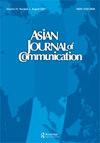Exploring the climate change discourse on Chinese social media and the role of social bots
IF 1.5
2区 文学
Q2 COMMUNICATION
引用次数: 0
Abstract
ABSTRACTWhile climate change discourse on Western platforms like Twitter often reveals signs of polarization and misinformation, discussions on Chinese social media remain less explored. Building on the theoretical framework of the green public sphere, this study aims to explore the features of the content (topics and veracity), the characteristics of engaged users (regular users and social bots), and the communication strategies adopted by engaged users in climate change discussions on Chinese social media. We employed machine learning methods to analyze 452,167 climate change-related posts generated by 311,214 users from 2010 to 2020 on Weibo, finding that climate change discourse concentrated on environmental and health impacts and action advocacy, and misinformation was not prevalent. Regarding the composition of engaged users, only a small proportion were social bots which concentrated on action advocacy and politics and governance, rather than skeptical and denialist discourses. In terms of communication strategies, we found that social bots on Weibo were more likely to forward a post or mention another user than regular users. This study expands our understanding of climate change discourse and the green public sphere on social media and provides insights into leveraging social bots in climate change communication in an AI-powered society.KEYWORDS: Climate changepublic discoursetopicsmisinformationsocial botssocial mediagreen public sphere Disclosure statementNo potential conflict of interest was reported by the author(s).Additional informationFundingThis work was supported by National Key Research and Development Program of China [Grant Number 2021YFF0901601].Notes on contributorsJiaojiao JiJiaojiao Ji (Ph.D., University of Science and Technology of China) is currently a Senior Research Fellow in the Department of Communication of Science and Technology at the University of Science and Technology of China. She was a visiting scholar at the University of California, Davis (2016–2017) and a visiting scholar at Annenberg School of Communication and Journalism, University of Southern California (2018–2019). Her interests lie in public opinion on social media, misinformation detection and correction, and computational methods.Ting HuTing Hu is currently a Ph.D. student in the Department of Communication of Science and Technology at the University of Science and Technology of China (USTC). Her current research interests include science communication and health communication on social media, computational methods in communication. Her research has been accepted by the 17th Public Communication of Science and Technology (PCST2023) conference.Zihang ChenZihang Chen is a master student majoring in Software Engineering in the Institute of Advanced Technology at the University of Science and Technology of China (USTC) in Hefei, China. He earned his Bachelor of Science degree in Computer Science and Technology from Jimei University in Xiamen, China, in 2020. His research focuses on data mining, natural language processing, and machine learning, and he has published a conference paper in these related fields.Mengxiao ZhuMengxiao Zhu is a Distinguished Research Fellow in the School of Humanities and Social Sciences, at the University of Science and Technology of China (USTC). She earned her Ph.D. Degree in Industrial Engineering and Management Sciences from Northwestern University. Before joining USTC, she worked as a Research Scientist in the Research and Development division at Educational Testing Service (ETS) for over seven years. Her current research interests include computational methods in communication, social networks and social media, and the interactions of AI and human in communication and education.探讨中国社交媒体上的气候变化话语和社交机器人的作用
摘要在推特等西方平台上的气候变化讨论经常显示出两极分化和错误信息的迹象,而中国社交媒体上的讨论仍然很少被探索。基于绿色公共领域的理论框架,本研究旨在探讨中国社交媒体气候变化讨论的内容特征(话题性和真实性)、参与用户特征(普通用户和社交机器人)以及参与用户所采取的传播策略。我们利用机器学习方法分析了2010 - 2020年间311214位微博用户发表的452167条与气候变化相关的微博,发现气候变化话语集中在环境和健康影响以及行动倡导上,错误信息并不普遍。从参与用户的构成来看,只有一小部分是社交机器人,这些社交机器人专注于行动倡导和政治治理,而不是怀疑和否认主义的话语。在传播策略方面,我们发现微博上的社交机器人比普通用户更有可能转发帖子或提及其他用户。这项研究扩展了我们对社交媒体上气候变化话语和绿色公共领域的理解,并为在人工智能驱动的社会中利用社交机器人进行气候变化交流提供了见解。关键词:气候变化公共话语话题误传社会媒体绿色公共领域披露声明作者未报告潜在利益冲突。本研究受国家重点研发计划资助[批准号:2021YFF0901601]。吉娇娇(中国科学技术大学博士),现任中国科学技术大学传播科学与技术系高级研究员。曾任加州大学戴维斯分校访问学者(2016-2017)、南加州大学安嫩伯格传播与新闻学院访问学者(2018-2019)。她的兴趣在于社交媒体上的舆论,错误信息的检测和纠正,以及计算方法。胡婷,中国科学技术大学传播科学与技术系博士研究生。目前主要研究方向为社交媒体上的科学传播与健康传播、传播中的计算方法。她的研究成果已被第17届科学技术公共传播大会(PCST2023)接受。陈子航(音译)是中国科学技术大学合肥先进技术学院软件工程专业的一名硕士研究生。他于2020年获得中国厦门集美大学计算机科学与技术学士学位。他的研究重点是数据挖掘、自然语言处理和机器学习,并在这些相关领域发表了一篇会议论文。朱梦晓,中国科学技术大学人文社会科学学院特聘研究员。她拥有西北大学工业工程与管理科学博士学位。在加入中国科大之前,她在美国教育考试服务中心(ETS)的研发部担任了七年多的研究科学家。主要研究方向为通信领域的计算方法、社交网络与社交媒体、通信与教育领域的人工智能与人的交互。
本文章由计算机程序翻译,如有差异,请以英文原文为准。
求助全文
约1分钟内获得全文
求助全文
来源期刊

Asian Journal of Communication
COMMUNICATION-
CiteScore
3.70
自引率
0.00%
发文量
38
期刊介绍:
Launched in 1990, Asian Journal of Communication (AJC) is a refereed international publication that provides a venue for high-quality communication scholarship with an Asian focus and perspectives from the region. We aim to highlight research on the systems and processes of communication in the Asia-Pacific region and among Asian communities around the world to a wide international audience. It publishes articles that report empirical studies, develop communication theory, and enhance research methodology. AJC is accepted by and listed in the Social Science Citation Index (SSCI) published by Clarivate Analytics. The journal is housed editorially at the Wee Kim Wee School of Communication and Information at Nanyang Technological University in Singapore, jointly with the Asian Media Information and Communication Centre (AMIC).
 求助内容:
求助内容: 应助结果提醒方式:
应助结果提醒方式:


